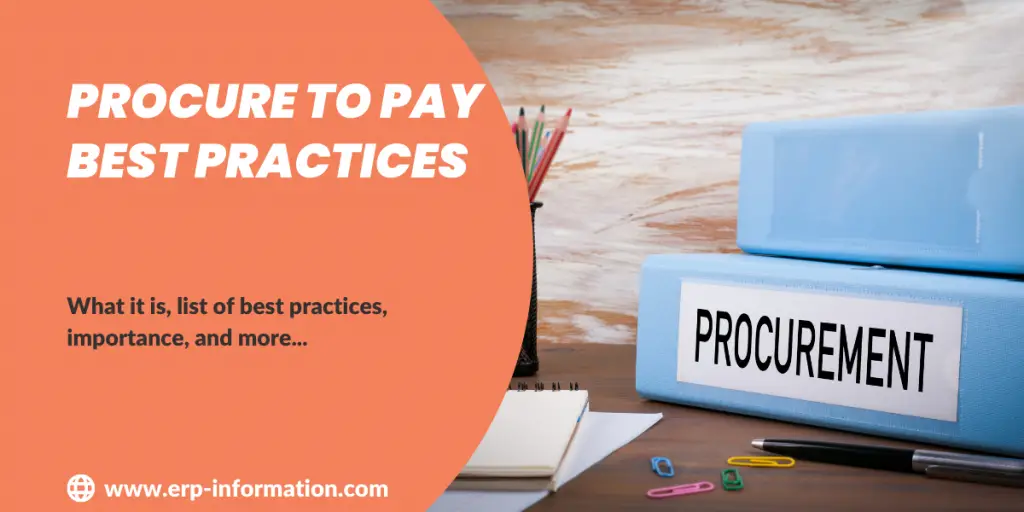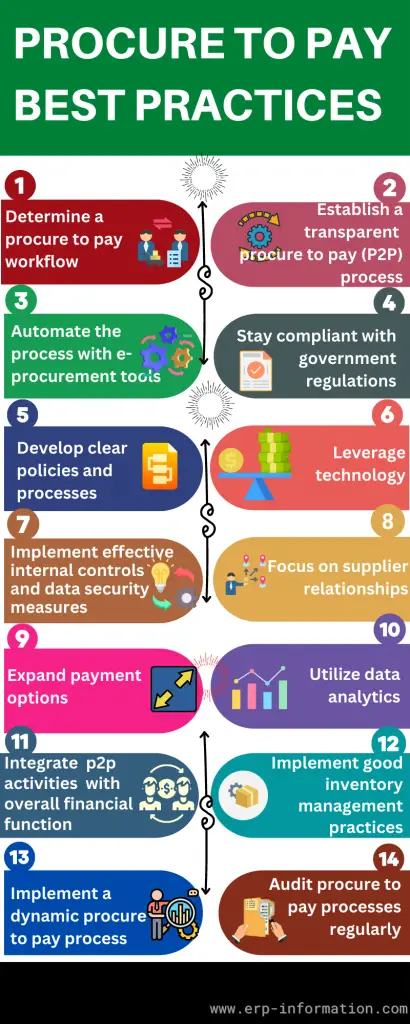Do you oversee procurement-to-pay processes within your organization?
Then it is important to stay informed about the latest and the best ways to do it. Procurement can be a bit intriguing, but in this blog post, we’ll talk about simple and effective practices that can make your buying and payment processes work better.
Read on to know, practical tips that can help your organization save money, run smoothly, and stay updated on the latest methods in procurement.
This blog post will discuss the 14 procure to pay best practices everyone should know. We’ll cover everything from automating procure-to-pay processes to ensuring compliance with government regulations.
Before knowing about procure-to-pay best practices, let us know What Procure-to-pay is?
What is procure to pay?
Procure to pay (P2P) is an end-to-end process that enables organizations to procure goods and services from vendors and manage the associated payment process.
It starts with a purchase request, followed by vendor selection, contract negotiation, issuing purchase orders, and finally, paying for the goods or services. The purchase requisition form documents all these activities of the firm.
The procure-to-pay process helps organizations manage the entire process from start to finish, ensuring that goods and services are purchased promptly and cost-effectively.
The procurement team takes the responsibility of end to end process. They decide what the organization needs and how much money to spend. The team can include people from different company parts, like finance, marketing, and engineering.
The P2P process is almost the same for all businesses. You can also learn about the P2P cycle in Oracle apps and the procure-to-pay cycle in NetSuite.
Let’s dive into the fourteen procure to pay best practices everyone should know.
Procure-to-pay best practices
1. Determine a procure-to-pay workflow
Determine a procure-to-pay workflow that includes all the necessary steps and processes to save time and money. That should include practices such as procurements, financial forecasting, budgeting, purchasing, invoice processing, supplier management, and payment.
2. Establish a transparent procure-to-pay (P2P) process
Establish a procure-to-pay (P2P) process that is streamlined, transparent, and automated. Start by standardizing procurements, streamlining order entry and approvals, eliminating manual processes, and automating vendor payments.
Additionally, providing visibility into procurements across the entire organization will create greater efficiency and cost savings.
3. Automate the process with e-procurement tools
E-procurement tools make procurements easier, faster, and more cost-effective. These tools can also help reduce manual administrative processes, automate processes, streamline operations, and reduce costs. Automation can also help to ensure compliance with procure-to-pay policies and regulations.
4. Stay compliant with government regulations
It is also important to ensure compliance with relevant government regulations. That ensures p2p processes are compliant and up to date. Ensure your organization has the necessary procedures to comply with applicable laws and regulations, and remember to review them regularly!
5. Develop clear policies and processes
Develop clear-cut p2p policies and processes that are easy to understand and follow. Ensure these policies outline the steps for procurements, approvals, payment terms, supplier management, and more. Additionally, ensure that all stakeholders can access these policies and easily update them as needed.
A well-defined policy will help ensure compliance with applicable regulations and reduce potential errors—document all procurements, purchases, payments, and any associated approvals.
6. Leverage technology
Technological advances can improve p2p processes in many ways. For example, automating procurements, invoicing, and payments can reduce administrative costs and improve reporting capabilities.
Additionally, leveraging technology to monitor purchases for potential fraud or overspending can help strengthen internal controls.
7. Implement effective internal controls and data security measures
Effective internal controls can ensure the accuracy of procurements, purchases, and payments. Data security measures such as encryption and two-factor authentication for p2p systems protect against fraud and cybercrime.
8. Focus on supplier relationships
Cultivating strong relationships with suppliers is essential to procure-to-pay best practices. In addition, working closely with suppliers can help decrease costs and ensure the timely delivery of goods and services. For that, have a strong vendor management system.
9. Expand payment options
Offer different payment methods such as PayPal, ACH, wire transfer, or credit card payments to provide vendors with more convenient payment options.
10. Utilize data analytics
Data analytics can help identify cost savings opportunities and spot trends in p2p processes, identify areas of improvement, and measure success. Additionally, implementing these insights can improve effectiveness, efficiency, and compliance.
11. Integrate procure-to-pay activities into the overall financial function
Connect procure-to-pay activities with the overall financial function to ensure visibility into procurements and payments. For example, integrating procure to pay with the accounts payable process can reduce errors and improve efficiency.
12. Implement good inventory management practices
Good inventory management helps ensure that procurements are made promptly and in the right quantities while reducing waste and costs associated with excess inventory.
13. Implement a dynamic procure-to-pay process
A dynamic p2p process should be able to adjust to changing market conditions and customer demands easily and quickly. This helps organizations remain competitive in today’s ever-changing landscape.
14. Audit procure to pay processes regularly
Audit P2P processes regularly to identify areas of improvement and ensure compliance with rules and regulations.
By implementing these procure-to-pay best practices, organizations can improve efficiency and reduce costs associated with procurements, purchases, and payments.
Additionally, having a well-defined process helps ensure compliance with applicable regulations.
Advantages of procure-to-pay process
The advantages of having an automated procure-to-pay process can include:
- Cost savings
- Better control over budgeting and spending
- Improved inventory management
- Even greater compliance with government regulations
The time and effort invested in designing a comprehensive procure-to-pay system will bring long-term rewards in process efficiency, bottom-line savings, and operational effectiveness.
Challenges of the P2P process
- The challenge of outdating technology
- Lack of coordination and communication may bring difficulty P2P process
- Departments can spend too much if they don’t have the right tool to track their spending
- Lack of visibility
- Invoice processing can be time-consuming
FAQs
What is the importance of procure-to-pay best practices?
Procure-to-pay best practices are highly important for organizations to ensure that they can procure the raw materials, goods, and services they need while maintaining control over costs, quality, and compliance. In addition, by properly managing these processes, companies can help to reduce unnecessary risks and improve operational efficiency.
How do procure-to-pay best practices help businesses?
Procure to pay best practices are beneficial for businesses in multiple ways.
First, it can help streamline purchasing processes and reduce costs by making getting the right products at the right prices easier. That helps to ensure businesses can maximize their resources and minimize expenses.
Secondly, P2P best practices can help decrease the risk of fraud and errors in procure-to-pay operations by providing more visibility into processes. As a result, businesses can ensure they are making informed spending decisions.
Finally, procuring-to-pay best practices can help create better relationships with suppliers since more transparency and trust are built into procure-to-pay operations.
The bottom line is that procure-to-pay best practices can help business processes more efficiently and cost-effectively.
Conclusion
Procure-to-pay (P2P) best practices are important for businesses of all sizes. Following this article’s tips, you can streamline your procure-to-pay process and improve your bottom line.
Understanding how each step in the process works together to achieve desired goals creates opportunities for making solid investments now that will deliver profits far into the future.
With careful planning and implementation, companies of any size should reap the numerous benefits of improved procure to pay best practices.

